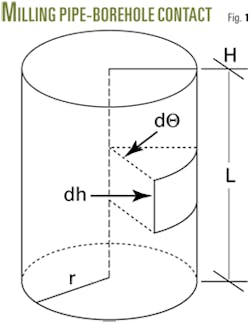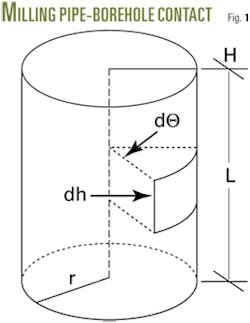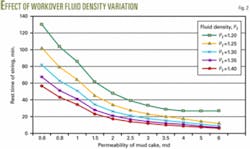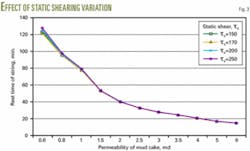Increasing casing failures in Daqing oil field have aggravated damage to wells. A new method to repair these failures removes and replaces damaged casing with a sleeve milling pipe string.
This is an economic and efficient well repair method, particularly for long well sections or wells with multiple casing failure points. It is also useful in small-diameter wells with casing failures that cannot be refitted or strengthened because of the reduced diameter.
But the application and development of this technology is restricted in deep well repair because the size of sleeve tool is relatively large and the annular clearance, relatively small. This leads to the serious problem of sticking the sleeve milling pipe string.
This article derives a mathematical relation between the sticking force and the longest rest time allowable for a sleeve tool in a well. Using computation along with site operation data can guide future operations to prevent sticking the string.
Technology
Using well repair technology to withdraw and replace damaged casing, only a section of failed casing needs to be removed. The failed well section can be rehabilitated perfectly; successful restoration of deep well casing sections in the Daqing field has been nearly 100%. Leakproof pressurization tests after repair produce the same result as that of newly drilled wells. Thus, various augmented injection means can be achieved.
This relatively thorough well repair method will be used more and more widely in oil field development. With increasing experience and maturity, this technology will be refined and eventually applied in production sections or even used throughout the entire wellbore.
Daqing well failures
Statistics from the “eighth five years” period (1991-95) show that there were about 300 casing failures in Daqing wells, the two main types of failure being:
- Corrosion of casing in a shallow surface layer.
- Distortion (necking) and point-shear of nip-off in the nonproducing section of the argillutite (black organic shale) marker bed in the NenEer formation.
In 1998, there were 664 casing failures in wells. This increased to 700 failures in 1999, and by the end of 2000, the total number of wells with casing failure was more than 6,000.
Seven casing-failure sheet regions emerged (west of central area, west area, north-Duan east, etc.). About 50% of the producing wells in these regions have been subject to casing failure. Therefore, improving the efficiency of repairs is strategically important. The wells must be repaired quickly and effectively in order to improve oil field exploitation.
The reasons for sleeve tools getting stuck are very complex. They relate to loose strata, the reservoir pressure system, the performance of workover fluid, and other factors. The relatively high density of workover fluid puts a pressure difference on the pipe string, which is the main reason that casing strings get stuck during withdrawal or replacement.
This article presents a comprehensive mathematical and mechanical analysis of the mechanism of sticking due to the pressure difference. It provides a mathematical model to calculate maximum allowable rest time and suggests corresponding preventive measures in order to prevent a string from getting stuck.
Theoretical modeling
String sticking due to a pressure difference means that a segment of the string squeezes into the mud cake and is held tightly in the mud cake by the positive differential pressure caused by the liquid head of the workover fluid and the reservoir pressure.
As a result of the interaction with mud cake and workover fluid, the string cannot move. This phenomenon mostly occurs in permeable strata, where thick mud cake is prone to develop.
Deriving and constructing a model in which string is prevented from getting stuck under the pressure difference followed these assumptions:
- The borehole face is rigid, and the influence between the string and the borehole face is considered in the friction coefficient.
- The gravitational, frictional, and adhesive forces acting on the string unit are uniformly distributed.
- The string unit for computing is regarded as a spatial circular arc curve.
- The friction coefficient, the adhesive force coefficient, and the density of workover fluid in a certain well section are regarded as constants.
- The string above the upper tangency point contacts consecutively with the borehole face.
Imagine that a section of string with a length, L, contacts the borehole face (Fig. 1). Equation 1 gives the relations based on an infinitesimal surface area dA on the contact face. Equation 2 shows the pressure difference between the workover fluid and the reservoir that acts on dA.
Several factors influence the reservoir hydrostatic column pressure gradient: fluid density, salt concentration, gas strength, and temperature gradient. High salt concentration will increase the hydrostatic column pressure gradient, and the increase of dissolved gas and the rising of temperature will make the hydrostatic column pressure gradient decrease.
Thus, Equation 3 shows the frictional force acting on the infinitesimal surface area dA; Equation 4 shows the total frictional force.
Equation 5 shows the adhesive force acting on dA. Equation 6 shows the total adhesive force, in which θ is the adhesive looping angle associated with the thickness of the mud cake and the contact face between the string and the mud cake. With the theoretical analysis and mathematic derivation of the string pressing into the borehole face, the adhesive looping angle θ is given in Equations 7 and 8.
The thickness of mud cake is related to the performance of workover fluid and formation factors, predominantly the permeability. The magnitude of water loss of the workover fluid is the dominant factor influencing the accretion of mud cake.
Under Darcy’s formula, the percolation ratio through medium can be expressed as shown in Equations 9 and 10.1
According to the relation between the filtrate volume of workover fluid and the solid content, Equation 11 can be drawn.
Inserting Equation 11 into Equation 10 will represent the relation between the mud cake thickness, Z, and the percolation time, t, resulting in Equation 12.
Equations 4 and 6 are the integral forms used to calculate the total friction force and adhesive force acting on the string. In practice, each meter length chosen from the contact face between the string and the borehole face can be used as the integrating block. That is, divide the entire length from top to bottom into L equal units, and the well depth corresponding to the i unit is h = H + i × 1(1 ≤ i ≤ L). Thus Equation 13 expresses the total friction force, and Equation 14 shows the total adhesive force.
Equation 12, which calculates the thickness of mud cake, is transformed into Equation 15. Equation 16 shows the minimum “unfreezing force” required in order to prevent the string from getting stuck.
If the hole deviation angle is α, the buoyant weight of the string in the workover fluid will change into Fb cosα. The friction force and the adhesive force that the sleeve tool is subjected to are Ff cosα and Fa cosα, respectively (Equation 17). Meanwhile, the side force that the string applies on the borehole face will increase the friction force between the string and the mud cake with an increment, Fbf sinα, so that Equation 16 can be rewritten as Equation 17.
Applying theoretical model
First, we must solve for the rest time given the weight on hook (hook load).
The summation of friction force, Ff, and adhesive force, Fa (the added resistance force shown in Tables 1 and 2), can be acquired by use of the maximal traveling hook load obtained in the field and subtracting the buoyant weight of the string in the workover fluid. The value of Fa equals 40-60% of the interacting force between string and mud cake.2 Then the value of Ff can be easily obtained.
Using the mathematic relation between Ff and the time, the longest rest time of string in borehole (called the “warning” time) can be solved. Operations performed within this time window will minimize, even prevent string sticking.
Tables 1 and 2 list the calculated results based on data obtained from 18 wells (North 1-Ding No. 2-446, North 1-6-Bing No. 035, et al.). The calculations were used to guide site operations. As a result, there was no sticking.
Analyze model
Next, we must analyze factors relating to the stuck string within the theoretical model.
Besides the formation parameters, there are still many significant parameters related to the workover fluid in the theoretical model. The analysis of the relative influential factors can therefore be continued.
Looking at the effect of the permeability, K, of the mud cake:The results of computing with the data obtained from two wells: North 1-Ding No. 2-446 and North 1-6-Bing No. 035, in the Daqing oil field show that the permeability, K, affects the rest time of string in borehole to a relatively large extent, especially when K is less than 3.0 md. The rest time will increase (greatly) as K decreases, as Fig. 2 shows.Fig. 2 shows the relation of the density of workover fluid and the rest time (the value of ρf). We observed that at the same permeability, the larger the value of the workover fluid, the shorter the rest time allowed for the string in the borehole, that is to say, the more likely that the string will get stuck. When K>5 and ρf>1.25, for example, the rest time of the string is only 6-9 min.
Learnings
This article provides a derivation of the mathematical relation between the sticking force and the longest allowable rest time for a sleeve tool in a well.
The authors performed computations using site operation data from Daqing field and showed that the results can successfully guide operations work and prevent the string from getting stuck. The rate of accidentally sticking the work string declined effectively, resulting in an economic benefit and significantly improving the withdrawing and replacing of well casing.
Using both modeling and actual well experience, the authors analyzed the factors affecting the sticking of the string. We determined that the density of workover fluid and the permeability of mud cake were the main factors and that properties of the subterranean formations were of lesser influence.
References
- Huang, Hanren and Yang, Kunpeng, “Process principle of mud fluid,” Publishing House of Petroleum Industry (Chinese language), 1981.
- Jia, Zhongxuan, “Simple analysis on factors of drill pipe sticking,” Journal of Drilling and Exploitation Technology (Chinese language), Vol. 12 (1984), No. 2, pp. 37-45.
The authors
Anhou Long (longanhou@ yahoo.com.cn) is an associate professor at the key laboratory of the Educational Ministry for Improving Oil and Gas Recovery, petroleum engineering department, Daqing Petroleum Institute, China. Long holds an MS (1994) in oil and gas well engineering from Daqing Petroleum Institute. He is a member of the Chinese Petroleum Society.
Shaobin Hu ([email protected]) is an instructor at the key laboratory of the Educational Ministry for Improving Oil and Gas Recovery, petroleum engineering department, Daqing Petroleum Institute, China. Hu holds an MS (2003) in oil and gas well engineering from Daqing Petroleum Institute. He is a member of the Chinese Petroleum Society.
Xinlin Guo ([email protected]) is an engineer at the second oil production factory, Daqing Oil Field Co. Ltd., China. Guo holds a BS (2000) in petroleum engineering from Daqing Petroleum Institute.










